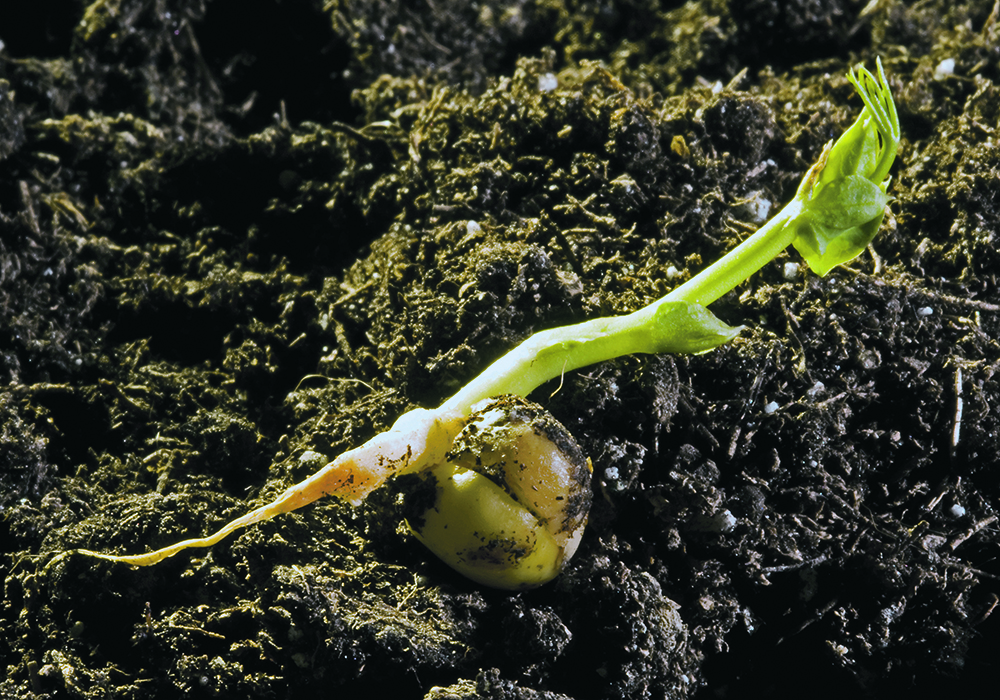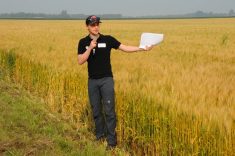Certified seed guarantees varietal purity, but specialists recommend testing all seed for germination, vigour and disease
Does certified seed mean guaranteed seed? Not necessarily, says a seed testing expert.
Certified seed goes through a battery of tests to ensure vigour, germination and disease-free status, but every seed – certified or not – should be tested for the basics before it goes in the ground, says the lab manager of an Alberta seed testing company.
“It’s dependent on the storage,” says Moses Palmer, of 20/20 Seed Labs south of Edmonton, speaking specifically about pulse seed. Germination can decline in storage.
“The label for verified seed is meant to provide growers with enough confidence to say ‘I’m buying this type of (seed).’ But it doesn’t take into account storage since the time the seed was certified or how it’s been handled.”
All pulse seeds, certified and bin-run, should be tested for germination, vigour and disease, says Palmer.
Dale Risula, a crop specialist with Saskatchewan Agriculture, defined germination as the seed’s ability to break the seed coat with roots expanding out of the seed.
“Vigour is more of a measure of how well it will withstand the climate once it does emerge and ends up above ground level.”
Jennifer McCombe-Theroux, a production specialist with Manitoba Pulse and Soybean Growers, puts it in even simpler terms: a germination test is conducted under optimal conditions while a vigour test is under adverse conditions.
“It just gives you insight on a seed lot and how it performs under challenging conditions,” she said.
Vigour testing, which includes a cold stress test, may be particularly important this year, Palmer says.
“We’re expecting to be going into a dry year this season and so we expect that at some point some growers will seed early to seed into moist soils. That means that the conditions are going to be cold at the time of seeding.”
These tests tell growers what they’re getting into with the seed they plan to plant, said Risula.
“You want to know what you’re facing.You should go into the growing season knowing what the risks are and be prepared to deal with them. If you can reduce those risks, then you’re going to be better off.”
McCombe-Theroux recommended seed testing once a crop reaches the moisture level at which a producer would want to store it. Testing for germination post-harvest can offer an early indication of a seed lot’s suitability for planting.
A pre-seeding test can either confirm the fall test or reveal flaws developed over the winter. Either way, it gives producers a better idea of germination capacity closer to seeding.
McCombe-Theroux recommends testing for mycosphaerella blight in peas. This disease is considered by Manitoba Pulse to be “the most widespread and economically damaging foliar disease in Manitoba field peas.”
Although blight is common, it’s not necessarily a threat at certain levels, she says. Testing indicates the seed’s level of infection.
“Up to 10 per cent infection should not significantly affect establishment of field peas depending on the germination level and spring conditions.”
McCombe-Theroux encourages dry bean growers to test for bacterial blight, which reduces the ability of dry bean leaves to photosynthesize. It’s only tested for in the U.S., but some producers consider it enough of a threat to send seed samples stateside for testing.
Producers can do some seed tests themselves by looking for hairline cracks in dry beans, peas and soybeans as well as seed coat integrity and “bald heads” — stumps on a seedling caused by mechanical damage to the growing point in dry beans.
“This is something growers can do at home to complement their germination test,” says McCombe-Theroux. “It’s something they can (use to) modify their seeding rates based on what they find.”
Michael Harding, plant pathologist with Alberta Agriculture and Irrigation, recommends that growers determine the risks they want to analyze and then talk to a seed testing lab to see what tests are available.
His recommendations focus on potentially harmful seed-borne or seed-transmitted bacteria and fungi.
“Some examples for pathogenic bacteria include pink seed on pea (Erwinia rhapontici) (and) bacterial blights (pseudomonas and xanthomonas species) and bacterial wilt (Curtobacterium flaccumfaciens) on pulse crops,” wrote Harding in an email.
“Seed-borne fungal diseases include ascochyta, fusarium and others.”
Palmer suggested that producers of vulnerable pulses test for aphanomyces, a soil-borne disease that causes root rot in peas.

Although seeds can be tested, aphanomyces usually involves a soil test. 20/20 labs, which also has a lab in Winnipeg, is set up for both, says Palmer.
“Most of the aphanomyces testing we do is in soil or on plant roots. We usually have customers pull out some plants in the field if they think they have some symptoms of aphanomyces or send us soil samples.”
If the disease is detected, there’s not much producers can do to get rid of it other than remove susceptible pulses from rotations and keep them out for several years, said Risula.
Tests should also be done for soybean cyst nematode, described by Manitoba Pulse as a microscopic roundworm that parasitizes soybean roots.
But farmers’ best bet may be a complete diagnostic test in which the lab plates the seeds and then tests them for a host of pathogens.
“Growers find that very useful because they can then use that information to determine the disease load on their seed,” Palmer says. “And then it would advise them on what kind of seed treatments, for example, to use.”
A seed sample should be representative of the seed lot. Taking seed from one portion of the bin of one per cent of a bag isn’t a representative sample, says Palmer. Producers should collect seed from different areas of the bin or bag, mix them together to form a composite sample and then take a sample from that.
20/20 Seed Labs has sample bags available on request.
“Otherwise, use a Ziploc bag, seal it nicely and put in a test for the kind of testing you require,” he says.
Different tests can require different seed counts, so growers should consult with the seed lab for confirmation.
Page 124 of Seed Manitoba’s 2024 Variety Selection and Growers Source Guide includes a list of accredited labs for Manitoba, Saskatchewan and Alberta.


















